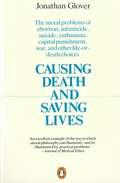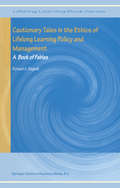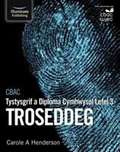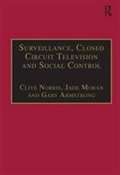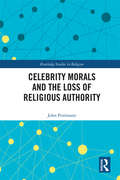- Table View
- List View
The Causes of War: Volume 1: 3000 BCE to 1000 CE
by Alexander GillespieThis is the first volume of a projected four-volume series charting the causes of war from 3000 BCE to the present day, written by a leading international lawyer, and using as its principal materials the documentary history of international law largely in the form of treaties and the negotiations which led up to them. These volumes seek to show why millions of people, over thousands of years, slayed each other. In departing from the various theories put forward by historians, anthropologists and psychologists, Gillespie offers a different taxonomy of the causes of war, focusing on the broader settings of politics, religion, migrations and empire-building. These four contexts were dominant and often overlapping justifications for the first four thousand years of human civilisation, for which written records exist.
The Causes of War: Volume II: 1000 CE to 1400 CE
by Alexander GillespieThis is the second volume of a projected five-volume series charting the causes of war from 3000 BCE to the present day, written by a leading international lawyer, and using as its principal materials the documentary history of international law, largely in the form of treaties and the negotiations which led up to them. These volumes seek to show why millions of people, over thousands of years, slew each other. In departing from the various theories put forward by historians, anthropologists and psychologists, Gillespie offers a different taxonomy of the causes of war, focusing on the broader settings of politics, religion, migrations and empire-building. These four contexts were dominant and often overlapping justifications during the first four thousand years of human civilisation, for which written records exist.
The Causes of War: Volume III: 1400 CE to 1650 CE
by Alexander GillespieThis is the third volume of a projected five-volume series charting the causes of war from 3000 BCE to the present day, written by a leading international lawyer, and using as its principal materials the documentary history of international law, largely in the form of treaties and the negotiations which led up to them. These volumes seek to show why millions of people, over thousands of years, slew each other. In departing from the various theories put forward by historians, anthropologists and psychologists, Gillespie offers a different taxonomy of the causes of war, focusing on the broader settings of politics, religion, migrations and empire-building. These four contexts were dominant and often overlapping justifications during the first four thousand years of human civilisation, for which written records exist.
The Causes of War: Volume 1: 3000 BCE to 1000 CE
by Alexander GillespieThis is the first volume of a projected four-volume series charting the causes of war from 3000 BCE to the present day, written by a leading international lawyer, and using as its principal materials the documentary history of international law largely in the form of treaties and the negotiations which led up to them. These volumes seek to show why millions of people, over thousands of years, slayed each other. In departing from the various theories put forward by historians, anthropologists and psychologists, Gillespie offers a different taxonomy of the causes of war, focusing on the broader settings of politics, religion, migrations and empire-building. These four contexts were dominant and often overlapping justifications for the first four thousand years of human civilisation, for which written records exist.
The Causes of War: Volume II: 1000 CE to 1400 CE
by Alexander GillespieThis is the second volume of a projected five-volume series charting the causes of war from 3000 BCE to the present day, written by a leading international lawyer, and using as its principal materials the documentary history of international law, largely in the form of treaties and the negotiations which led up to them. These volumes seek to show why millions of people, over thousands of years, slew each other. In departing from the various theories put forward by historians, anthropologists and psychologists, Gillespie offers a different taxonomy of the causes of war, focusing on the broader settings of politics, religion, migrations and empire-building. These four contexts were dominant and often overlapping justifications during the first four thousand years of human civilisation, for which written records exist.
The Causes of War: Volume IV: 1650 - 1800
by Alexander GillespieThis is the fourth volume of a projected six-volume series charting the causes of war from 3000 BCE to the present day, written by a leading international lawyer, and using as its principal materials the documentary history of international law, largely in the form of treaties and the negotiations which led up to them. These volumes seek to show why millions of people, over thousands of years, slew each other. In departing from the various theories put forward by historians, anthropologists and psychologists, the author offers a different taxonomy of the causes of war, focusing on the broader settings of politics, religion, migrations and empire-building. These four contexts were dominant and often overlapping justifications during the first four thousand years of human civilisation, for which written records exist.
The Causes of War: Volume IV: 1650 - 1800
by Alexander GillespieThis is the fourth volume of a projected six-volume series charting the causes of war from 3000 BCE to the present day, written by a leading international lawyer, and using as its principal materials the documentary history of international law, largely in the form of treaties and the negotiations which led up to them. These volumes seek to show why millions of people, over thousands of years, slew each other. In departing from the various theories put forward by historians, anthropologists and psychologists, the author offers a different taxonomy of the causes of war, focusing on the broader settings of politics, religion, migrations and empire-building. These four contexts were dominant and often overlapping justifications during the first four thousand years of human civilisation, for which written records exist.
The Causes of War: Volume V: 1800-1850
by Dr Alexander GillespieThis is the fifth volume in a series charting the causes of war from 3000 BCE to the present day,written by a leading international lawyer.While contextualised in the conflicts and patterns of the period, this work, as drawn directly from the treatiesand the negotiations which led up to them, shows what made both war and peace. The period covered inthis volume, 1800 to 1850, brings this series into the start of the modern world.
The Causes of War: Volume V: 1800-1850
by Dr Alexander GillespieThis is the fifth volume in a series charting the causes of war from 3000 BCE to the present day,written by a leading international lawyer.While contextualised in the conflicts and patterns of the period, this work, as drawn directly from the treatiesand the negotiations which led up to them, shows what made both war and peace. The period covered inthis volume, 1800 to 1850, brings this series into the start of the modern world.
Causing Death and Saving Lives: The Moral Problems of Abortion, Infanticide, Suicide, Euthanasia, Capital Punishment, War and Other Life-or-death Choices (Pelican Ser.)
by Jonathan GloverThe moral problems of abortion, infanticide, suicide, euthanasia, capital punshiment, war and othe life-or-death choices.
Causing Psychiatric and Emotional Harm: Reshaping the Boundaries of Legal Liability
by Harvey TeffThough mental harm can be profoundly disabling, the law imposes strict limits on who can recover damages for it. In the absence of physical injury, compensation is not normally available for negligently caused mental suffering, however severe, unless it constitutes a 'recognisable psychiatric illness'. Claimants whose mental trauma stems from injury caused to someone else are subject to arbitrary restrictive liability rules that dispense with established legal principles and cannot be reconciled with scientific advances. The book traces the history of civil liability for mental harm up to the present day. It is argued that the reluctance to provide redress reflects an enduring suspicion of intangible injury and undue fear of proliferating claims. The scale and legal ramifications of the Hillsborough disaster; the emergence of claims arising from work-related stress, and other new categories of claims based mainly on prior relationships between the parties, have all added to a 'floodgates fear' that has intensified due to popular perceptions of a 'compensation culture'. The book contrasts the limited scope for liability under English law with developments in several other jurisdictions. It is argued that statutory reform is needed to achieve greater legal coherence and to provide a remedy that tracks the impact and severity of harm and is not confined to psychiatric disorders. A new legal framework is offered, rooted in reasonable foreseeability of mental or emotional harm, with a liability threshold of 'moderate severity'. To allay concerns about proliferating claims, modifications to the compensatory regime for personal injury are proposed.
Cautionary Tales in the Ethics of Lifelong Learning Policy and Management: A Book of Fables (Lifelong Learning Book Series #1)
by Richard G. BagnallThis work is concerned with appraising the contemporary ethical impact of lifelong learning ideology and advocacy on education, through focusing on trends in educational policy and management that flow from the ideology. It has its origins in the author's concern that many of those trends are being defmed and promoted, or opposed, without an adequate understanding of their ethical dimensions. The 21 trends examined in this work are seen as defming important dimensions of the quite radical changes in educational policy and management that are flowing from the practical realisation of lifelong learning ideology and advocacy. In here evaluating those trends from an ethical perspective, the thesis is developed that they lead inevitably to distinctive ethical dilemmas or tensions in the lived experience of educational participants. The dilemmas, though, are not seen as realities that can intelligently be either avoided or resolved. They are, rather, inescapable features of the trends, although they and the experience of them may be managed intelligently to a greater or lesser extent. This analysis is premised on the belief that an understanding of the dilemmas may be of practical value in assisting educators, and policy makers and managers, to live and work more intelligently with them and to better manage the educational changes that are defmed by the trends. It may thereby contribute to moderating the excesses, sillinesses, and inanities so often evident in the directing and managing of refonns associated with the trends and to reduce the anguish and pain associated with them.
Cavendish: AS Level Lawcard (Lawcards)
by Routledge-CavendishCavendish Lawcards are complete, pocket-sized guides to key examinable areas of the law for both undergraduate and PGDL courses. Their concise text, user-friendly layout and compact format make Cavendish Lawcards the ideal revision aid for identifying, understanding, and committing to memory the salient points of each area of the law.
Cavendish: AS Level Lawcard (Lawcards)
by Routledge-CavendishCavendish Lawcards are complete, pocket-sized guides to key examinable areas of the law for both undergraduate and PGDL courses. Their concise text, user-friendly layout and compact format make Cavendish Lawcards the ideal revision aid for identifying, understanding, and committing to memory the salient points of each area of the law.
Cavendish: Business Lawcards (Lawcards)
by Routledge-CavendishCavendish lawcards are complete pocket sized guides to the key examinable areas of law. Their concise text, user-friendly layout and compact format makes them the ideal revision aid for identifying, understanding and memorizing the vital aspects of each area of law. Important features of the new edtion include: New four colour text design for easier navigation throughout each book Colour coded highlighting of cases and legislation Diagrams and flowcharts Bullet points of crucial information
Cavendish: Business Lawcards (Lawcards)
by Routledge-CavendishCavendish lawcards are complete pocket sized guides to the key examinable areas of law. Their concise text, user-friendly layout and compact format makes them the ideal revision aid for identifying, understanding and memorizing the vital aspects of each area of law. Important features of the new edtion include: New four colour text design for easier navigation throughout each book Colour coded highlighting of cases and legislation Diagrams and flowcharts Bullet points of crucial information
CBAC Safon Uwch Y Gyfraith Llyfr 1 (PDF)
by Sara Davies Karen Phillips Louise Draper-WaltersTwo new A Level Law books, designed to be used together, which cover all the content for WJEC and Eduqas A Level Law, for first teaching from September 2017. Book 1 covers all the content of the Year 1 and AS course, and provides some content for the Year 2 and A2 course.
CBAC Safon Uwch Y Gyfraith Llyfr 2 (PDF)
by Sara Davies Karen Phillips Louisa Draper-WaltersTwo new A Level Law books, designed to be used together, to cover all the content for WJEC and Eduqas A Level Law, for first teaching from September 2017. Book 2 covers the additional content needed for the Year 2 and A2 course.
CBAC Tystysgrif a Diploma Cymhwysol Lefel 3 Troseddeg (PDF)
by Carole A HendersonEndorsed by WJEC and written by experienced Criminology teacher and examiner Carole A Henderson, this student book offers high quality support you can trust. Accessible and student-friendly design to inspire and motivate students.
CCCTB: Selected Issues
by Dennis WeberThe European Commission’s proposed Common Consolidated Corporate Tax Base (CCCTB) is the most ambitious project in the history of direct taxation within the EU. While retaining the right of Member States to set their own corporate tax rate, the proposed system allows for a ‘one-stop shop’ for filing tax returns and consolidating prof its and losses across the EU. In this book – the first to offer guidance to practitioners whose work will be affected by these new developments – 19 prominent representatives of the business community, tax consultancy, academic taxation scholarship and tax administration discuss the proposed system’s rationale, structure and uncertainties, ranging from very technical aspects, to the wording of the proposal, to political considerations. These topics include the following: eligibility; formation of a group; the concept of ‘permanent establishment’; foreign tax credits; ‘dual resident’ companies; consequences of entering and leaving; depreciation of fixed assets; repackaged asset transfers; appeals procedure; disagreements among Member States; subsidiarity and the ‘yellow card procedure’; international aspects and tax treaties; sharing mechanism and transfer pricing; and anti-abuse rules. The discussion raises numerous issues likely to lead to future amendments, and for this reason, along with its practical value in developing an understanding of the proposed system’s specific effects, the book will be welcomed by tax consultants and lawyers worldwide, corporate tax advisers, European tax authorities and tax researchers and academics.
CCCTB: Selected Issues
by Dennis WeberThe European Commission’s proposed Common Consolidated Corporate Tax Base (CCCTB) is the most ambitious project in the history of direct taxation within the EU. While retaining the right of Member States to set their own corporate tax rate, the proposed system allows for a ‘one-stop shop’ for filing tax returns and consolidating prof its and losses across the EU. In this book – the first to offer guidance to practitioners whose work will be affected by these new developments – 19 prominent representatives of the business community, tax consultancy, academic taxation scholarship and tax administration discuss the proposed system’s rationale, structure and uncertainties, ranging from very technical aspects, to the wording of the proposal, to political considerations. These topics include the following: eligibility; formation of a group; the concept of ‘permanent establishment’; foreign tax credits; ‘dual resident’ companies; consequences of entering and leaving; depreciation of fixed assets; repackaged asset transfers; appeals procedure; disagreements among Member States; subsidiarity and the ‘yellow card procedure’; international aspects and tax treaties; sharing mechanism and transfer pricing; and anti-abuse rules. The discussion raises numerous issues likely to lead to future amendments, and for this reason, along with its practical value in developing an understanding of the proposed system’s specific effects, the book will be welcomed by tax consultants and lawyers worldwide, corporate tax advisers, European tax authorities and tax researchers and academics.
Cctv, Surveillance And Social Control
by Clive Norris Jade Moran Gary ArmstrongThe rise of CCTV camera surveillance in Britain has been dramatic. Practically every major city now boasts a CCTV system aimed at, among other things, preventing, detecting and reducing the fear of crime. Increasingly these developments are mirrored in villages, shopping malls, residential estates, transport systems, schools and hospitals throughout the country. In short, for the majority of citizens it is now impossible to avoid being monitored and recorded as we move through public space. Surveillance, CCTV and Social Control represents the first systematic attempt to account for this phenomenon. It brings together leading researchers from the fields of anthropology, criminology, evaluation, geography, sociology and urban planning to explore the development, impact and implications of CCTV surveillance. Accordingly attention is directed to a number of key questions. How does CCTV fit with the trends of late modernity? Does CCTV reduce crime or merely shift it elsewhere? How should CCTV be evaluated? What is the significance of CCTV for women's safety? How adequate is the regulation of CCTV? In the light of recent technological developments what is the future of CCTV surveillance?
Celebrity Morals and the Loss of Religious Authority (Routledge Studies in Religion)
by John PortmannThis book examines American popular culture to demonstrate that celebrities have superseded religious figures as moral authorities. As trust in religious institutions has waned over recent decades, the once frivolous entertainment fringe has become the moral center. Young people and voters increasingly take cues from actors and athletes. The book begins by offering a definition of celebrity and showing that the profile of celebrities has changed dramatically, particularly since the 1960s. They can now chart their own careers, manage their own personal lives and weigh in on pressing moral issues in a manner that hasn’t always been the case. This can be to the good, it is argued, for some counterintuitive reasons. Very few stars pretend to be moral exemplars, unlike the frequently hypocritical elites they have replaced. Others, however, are seemingly poorly qualified to speak on complex moral issues. In the end, it also turns out that who tells us how to feel about any moral issue counts at least as much as what they tell us. This is a fresh look at the impact of celebrity culture on contemporary morality and religious authority. As such, it will be of great use to academics working in religious studies and ethics, as well as popular culture and media studies.
Celebrity Morals and the Loss of Religious Authority (Routledge Studies in Religion)
by John PortmannThis book examines American popular culture to demonstrate that celebrities have superseded religious figures as moral authorities. As trust in religious institutions has waned over recent decades, the once frivolous entertainment fringe has become the moral center. Young people and voters increasingly take cues from actors and athletes. The book begins by offering a definition of celebrity and showing that the profile of celebrities has changed dramatically, particularly since the 1960s. They can now chart their own careers, manage their own personal lives and weigh in on pressing moral issues in a manner that hasn’t always been the case. This can be to the good, it is argued, for some counterintuitive reasons. Very few stars pretend to be moral exemplars, unlike the frequently hypocritical elites they have replaced. Others, however, are seemingly poorly qualified to speak on complex moral issues. In the end, it also turns out that who tells us how to feel about any moral issue counts at least as much as what they tell us. This is a fresh look at the impact of celebrity culture on contemporary morality and religious authority. As such, it will be of great use to academics working in religious studies and ethics, as well as popular culture and media studies.
Cell Phone Location Evidence for Legal Professionals: Understanding Cell Phone Location Evidence from the Warrant to the Courtroom
by Larry DanielCell Phone Location Evidence for Legal Professionals: Understanding Cell Phone Location Evidence from the Warrant to the Courtroom is a guide, in plain language, for digital forensics professionals, attorneys, law enforcement professionals and students interested in the sources, methods and evidence used to perform forensic data analysis of cell phones, call detail records, real time ping records and geo-location data obtained from cellular carriers and cell phones. Users will gain knowledge on how to identify evidence and how to properly address it for specific cases, including challenges to the methods of analysis and to the qualifications of persons who would testify about this evidence. This book is intended to provide digital forensics professionals, legal professionals and others with an interest in this field the information needed to understand what each type of evidence means, where it comes from, how it is analyzed and presented, and how it is used in various types of civil and criminal litigation. Relevant case law are included, or referred to, as appropriate throughout this book to give the reader an understanding of the legal history of this type of evidence and how it is being addressed by various state and federal courts. Presents the most current and leading edge information on cell phone location evidence, including how cell phone location works, and how evidence is used and presented in courtCovers tactics on how to locate cell phones and cell phone recordsProvides the first book to take an in-depth look at cell phone location evidence for digital forensics, legal and law enforcement professionalsIncludes a companion website with full-color illustrations of cell phone evidence and how cell phones work






